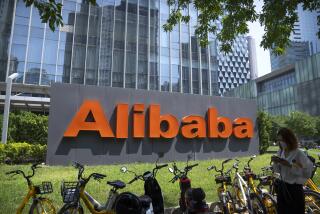China Puts Stock Show on the Road
- Share via
China’s Shanghai Vacuum Electron Devices Co. has only been publicly traded for nine months, but General Manager Wen-Hai Xue is quickly mastering the art of shareholder relations.
It is true, he conceded to a questioner at a meeting in Century City on Friday, that the stock has tumbled from $70.10 a share at its February offering to $47.20 now.
But of course, “We believe that has nothing to do with the performance of the company,” the amiable Wen-Hai insisted, via translator.
If his answer sounds almost too typically corporate, it may be calculated to be so: Several of China’s newly public companies, which recently have been on their first major “road show” for American investors, demonstrated a keen understanding of Western business sense--and what it takes to pitch a stock story to potential buyers.
There were slide presentations, videos, handouts, even an offer by the Shanghai Dazhong Taxi Co.’s general manager, Yang Guoping, for American investors to visit Shanghai and “ride our taxis--and if you do, all expenses will be paid for.” (Presumably, air fare isn’t included.)
The show, sponsored by brokerage Bear, Stearns & Co. and held at its Los Angeles office Friday after stops in New York and Chicago, was hardly slick by Western standards. The audiovisuals, for example, had a 1950s-America look to them.
Nonetheless, the event carried a powerful message about change in China, and the investment opportunities unfolding in that nation of 1.2 billion.
While its politics remain officially socialist, China’s economics have grown increasingly capitalistic since 1978 under leader Deng Xiaoping. The nation’s economy exploded at an annualized real growth rate of 9.3% in the 10 years ended in 1991.
The pragmatic Deng’s message to the West has essentially been, Don’t worry about how we do it, just watch what we do. Or as he put it in a now-famous quote, “No matter black or white, it is a good cat as long as it catches mice.”
If there was any remaining doubt about the permanence of Deng’s reforms, say China’s Western boosters, it should have been put to rest by the Chinese Communist Party’s official embrace of a market economy in its 14th party congress, which closed Oct. 18.
Indeed, Wang Xue Xiang, China’s consul general, boasted to investors at the meeting Friday that his nation is well on its way to becoming the world’s third-largest economy by 2005, up from seventh currently.
Getting there, however, will take enormous investment, especially from the West. Hence, the Chinese this year opened their fledgling stock markets--in the boom cities of Shanghai and Shenzhen--to foreigners for the first time since 1949, via special “B” shares.
The sex appeal of buying Chinese stocks is obvious: If China’s economy mushrooms as expected, the payoff for Western investors who buy stock early in fast-growing Chinese companies could be huge. Japan’s economic miracle, after all, turned a $10,000 investment in the Tokyo stock market in 1962 into $1.3 million by 1991.
Yet so far, China’s plunge into open share ownership has been less than confidence-inspiring:
* Of the nine B-class stocks that have been issued on the Shanghai Securities Exchange this year, all but one were recently trading below their initial offering prices. Many are down 20% or more.
At Bear, Stearns’ office Friday, officials of Shanghai Vacuum, Shanghai Tyre & Rubber and Shanghai Dazhong Taxi conceded that many Western investors are skeptical of China’s B shares, given the relative lack of research on the issuing companies and the difficulty in placing and clearing trades.
Also, strong interest in the stocks earlier in the year evaporated in summer, when Western investors feared that a planned deluge of new B shares would overwhelm demand and pull down share prices. Since then, the Chinese have adopted a go-slow approach.
* Meanwhile, trading in “A” shares available only to Chinese investors has become a classic case of absurd speculative excess in both Shanghai and Shenzhen.
China’s savings rate is about 36%, a function of the relative lack of goods on which to spend. With plenty of cash, or renminbi, in hand, the Chinese are eager to invest--probably too eager.
A tally by Bear Stearns in August showed many A shares trading at prices more than 100 times the companies’ estimated 1992 earnings per share--a multiple five times as great as Western investors are paying for most B shares.
What the stocks are truly worth is anyone’s guess. As the road show illustrated, the newly public Chinese firms appear to have great promise. But whether they can prosper--or even survive--in the fast-changing Chinese and global economies remains uncertain.
Shanghai Dazhong Taxi, for example, now racks up 30% net profit margins, an outrageously high level. But investors can’t be sure how many other taxi companies might spring up in Shanghai over the next decade. Nor can they be sure how successful the firm might be in the myriad other businesses it says it will enter, including motels, commercial real estate and even department stores.
Donald Tang, a 29-year-old investment whiz recently named president of Bear Stearns Asia, advises caution for Americans thinking about investing in China. If growth unfolds as expected, there will be plenty of opportunities to get in along the way, he notes. So there’s no need to rush. But neither should Americans just assume China’s market will never grow up, Tang adds.
“It’s a baby market now, but it’s going to explode,” he says.
China’s New Stocks: Three Examples Here are some financial and business details on three of the nine Shanghai-traded stocks available to Western investors. Shanghai Tyre and Rubber Estimated 1992 profit: $41 million Estimated 1992 earnings growth: 134% Initial ‘B’ class stock price: $11.01 on 8/28/92 Friday ‘B’ class stock price: $8.90 Estimated 1992 price-to-earnings ratio: 15 No. of ‘B’ shares outstanding: 17 million Background: China’s largest maker of motor vehicle tires; produced three million in 1991. Total sales: $233 million. Formed by merger of two 64-year-old plants. Says it can only satisfy two-thirds of current domestic demand for its brands, but also admits it couldn’t compete with foreign tire makers because of material costs and quality issues. Shanghai Dazhong Taxi Estimated 1992 profit: $4.3 million Estimated 1992 earnings growth: 42% Initial ‘B’ class stock price: $6.52 on 7/22/92 Friday ‘B’ class stock price: $7.85 Estimated 1992 price-to-earnings ratio: 17 No. of ‘B’ shares outstanding: 2.5 million Background: Formed in 1988 to alleviate chronic taxi shortage in Shanghai. Adopted the Western practice of stopping for hailing customers instead of responding only to phone bookings. Known as “Red Whirlwind” for cars’ bright red color. Owns 1,000 sedan taxis, making it No. 2 in Shanghai. 1991 sales: $15 million. Shanghai Vacuum Electron Device Estimated 1992 profit: $13 million Estimated 1992 earnings growth: 124% Initial ‘B’ class stock price: $70.10 on 2/21/92 Friday ‘B’ class stock price: $47.20 Estimated 1992 price-to-earnings ratio: 14 No. of ‘B’ shares outstanding: 1.0 million Background: Makes black/white and color picture tubes for TVs; also radios, video players, fluorescent lamps, car headlamps. First ‘B’ share on the market. Entered joint ventures with Japan’s Toshiba and America’s Corning Glass to upgrade plant technology. Gearing up for production of 25-inch color TVs, a first. Employs 15,000. Source: Ong & Co., companies listed
More to Read
Inside the business of entertainment
The Wide Shot brings you news, analysis and insights on everything from streaming wars to production — and what it all means for the future.
You may occasionally receive promotional content from the Los Angeles Times.










